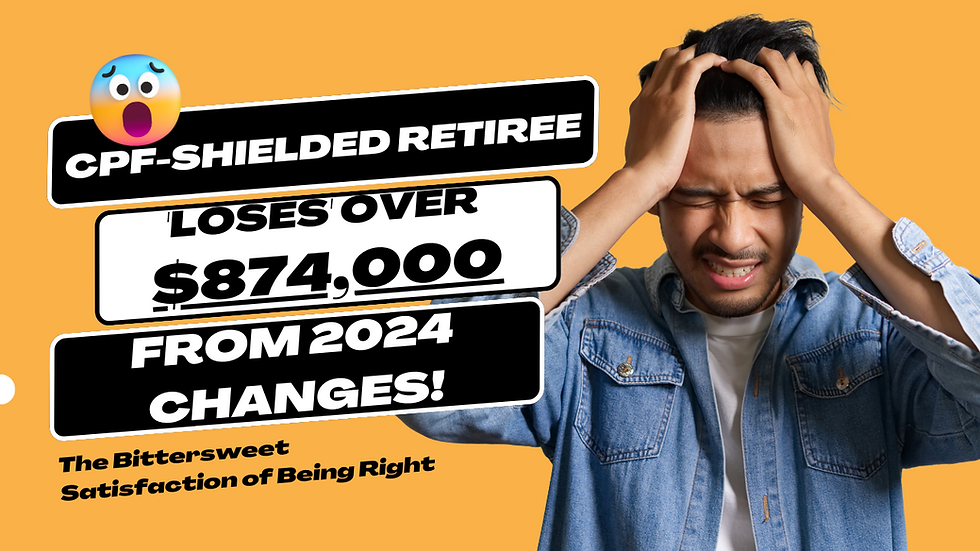My Guide to the CPFIS, Part II
- Money Maverick

- Sep 12, 2019
- 4 min read
Updated: Feb 9, 2023
It has been fed-back to me that I might have taken the previous post a bit too far.
So I made some amendments. You can read the original, now amended post here:
The article includes some pointers about CPFIS and its potential returns, which can be significantly higher than that of its current interest rates. For those of you who are still generally interested in investing your CPFIS - here's some additional advice not limited to investment funds. This was the original ending for the previous article, but it made it too long and I had intended to use them as captions.

I hope you find it useful.
1) Ignore Bonds, or Majority Bonds
What I’ve noticed when I’m correcting CPF portfolios sometimes is that the advisor or the investor played it too safe.
So yes, they want to invest their monies, but they still want capital preservation.
Unfortunately, if you wanted to achieve that CPF was already the best risk-free investment. Even the best bond in the world wouldn’t produce that kind of risk-adjusted return, because CPF Bonds are literally ranked the best bonds in the world already.
If you really want to make higher returns using a different source, or generally prepared to trade small risk free returns for potentially higher returns, you have to take on more risk.
(That is also partly why I did the filtering of funds in the previous article.)
In fact, as a general rule you should typically ignore most defensive or conservative instruments, if the goal is to surpass the 2.5% interest rate.
If you have a different goal, like owning gold shares or something, that’s a whole other story.
2) Adjust Your Expectations
Once you’re prepared to take higher risk, do adjust your expectations. Higher risk assets such as equities do not typically grow 6% year on year, for example – it’s more like (-8%, +27%, +12%, -12%, +16%).
Try the numbers above in your calculator with a $100,000 capital and then look at the annualized/compounded return. Surprised at the huge change in numbers? That's a mere 6% annualized return. Imagine 8%, or higher.
The absolute numbers can be really heart wrenching despite being a small percentage in reality. It can be jarring if you expect a smooth curve, so don’t – and you won’t panic when the losses happen because they’re bound to recover over time.

3) Figure out your Mortgage First, man
A common strategy is to not wipe out your entire OA by putting some of it aside for investing. Other people will want to maximise their returns as early as possible, since the difference between 2.5% and 6% for example, is massive and they want to get started as quickly as possible.
It gets very complex when you toss your mortgage payments into the picture, especially if you're committing regularly (e.g. monthly) and your mortgage can fluctuate (e.g. private mortgages, fixed/floating etc). It's really a lot easier to just figure out your mortgage, leave a margin of safety for interest fluctuations and then invest the rest.
4) Decide which CPF Life you want
Some people have broken down CPF to an absolute science.
And that science tells you that certain CPF strategies have numerical advantages over other CPF strategies. I'm not going to go over them in too much detail, but you should probably get formal advice on that.
Some of you may want to secure your base numerically before starting investing. This is a slightly more conservative way where you have a considerable amount of CPF in your accounts before you even consider investing.
Some of you will secure this base by calculating far ahead (using compounded interest of the CPF accounts versus the growth of the BRS or FRS). Slightly more calculative, still fairly conservative.
Some of you will invest in order to meet this sum.
Some of you will plan for a ton of excess at 55.
Some of you will not invest at all after figuring all of that out.
There’s so many terms and choices, too. Basic, standard, escalating, BRS, FRS, ERS, OA, SA, RA, the bonuses and interest rates or all of them…
Choose the CPF Life plan you want and it’ll be way easier to plan how to allocate your CPFIS. Trust me. Doing otherwise is hell.
5) Mix and Match
There is a 35% cap on stocks and REITs for your CPF OA.
I’m not the biggest fan, but there’s nothing to stop you from doing it. The options are available.
If anything, you should consider it if you’re someone like me. Because you can try it, take losses for a while and always crawl back to guaranteed interest if it turns out to not be your cup of tea.
Or it could be awesome and you’ll want to explore it further. Who knows?
Ultimately, investing is a contact sport. You won’t really know until you try.
Money Maverick
*Investments above are available using CPF (Ordinary Account), SRS (Supplementary Retirement Scheme) and Cash.
#investments #markets #returns #moneymaverick #financialadvisor #investmentprofessional #investmentspecialist #highrisk #highreturn #volatility #sharperatio #beta #alpha #returnrisk #highreturns #investment #investing #growth #snp500 #etfs #funds #financialplanning #financialconsultant #diversification #riskmanagement






Comments